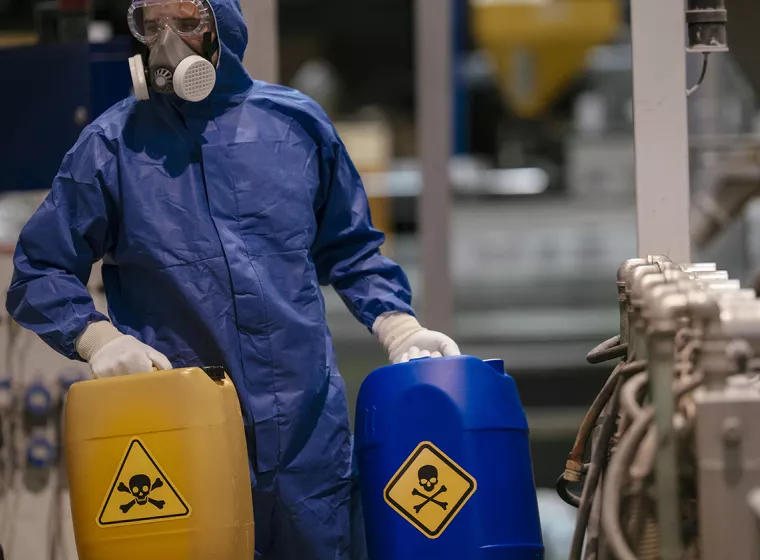April 7, 2022
Challenges & opportunities in the expanded use of fenceline monitoring for hazardous air pollutants at industrial facilities
In a recent settlement with the U.S. Environmental Protection Agency (EPA) and the Department of Justice, Chevron Phillips Chemical Company agreed to implement a fenceline monitoring system at three petrochemical plants in Texas, which may be a bellwether for future agency actions. EPA has recently invested significant resources to expand fenceline monitoring technology with an aim to see it more widely deployed in sectors outside of refining. Technology development has included field testing a range of lower cost sensors and evaluating their ability to sample pollutants from a range of chemical industries.
The Chevron settlement provides a framework for monitoring concentrations of hazardous air pollutants, public reporting, and implementing mitigation when exceedances are found. Other companies may want to proactively consider implementing a similar framework to establish a track record of information and gain the confidence of both regulators and the community. Implementation, however, requires understanding technological limitations and assumptions, handling large datasets, determining robust safe limits, and implementing specific operating procedures in the event of measured exceedances.
Growing interest in fenceline monitoring
EPA, states, and other regional stakeholders have increasingly used fenceline monitoring for hazardous air pollutants to understand industrial emissions and their impacts on neighboring communities. In December 2015, EPA published its Petroleum Refinery Sector Rule, which introduced requirements for refineries to monitor air concentrations of benzene at their fencelines. Data collected through this program are publicly reported and can be used by the public and regulators to understand impacts in adjacent neighborhoods.
The process of monitoring, reporting, and performing analysis of any exceedances is a powerful tool for understanding fugitive emissions.
In October 2017, the California State Assembly passed Assembly Bill 1647, which led to individual air districts adopting rules that require fenceline monitoring at refineries for benzene along with a list of other hazardous air pollutants. California's AB 1647 also used industry funding to expand community air monitoring sites.
The joint explanatory statement for the recently passed "Consolidated Appropriations Act, 2022" further supports the shift to fenceline monitoring technologies, including special emphasis on its use around disadvantaged communities:
"The Committees urge the Agency [EPA] to prioritize air quality monitoring systems that yield frequently repeated measurements of pollutants and identify hotspots or areas of persistent elevated levels of pollutants localized to and caused by the characteristics of a specific geographic location. The Committees encourage the Agency to utilize this information to provide regularly updated data to overburdened and marginalized communities and for public awareness and other activities."
Such emphasis on air quality monitoring in environmental justice communities represents an extension of prior efforts in the refinery sector and likely indicates future trends.
The Chevron settlement framework
The Chevron settlement covers three Texas petrochemical facilities in Port Arthur, Cedar Bayou, and Sweeney, where flares were found to have not been properly maintained or operated. In addition to installing pollution control equipment and emissions monitoring systems and paying civil fines, Chevron also agreed to install fenceline monitoring for benzene where exceedances of thresholds would result in root-cause analysis and corrective actions.
The process of monitoring, reporting, and performing analysis of any exceedances is a powerful tool for understanding fugitive emissions. If implemented proactively, it has the potential to help industrial facilities improve operations, regulatory compliance, and community relations — so long as the data generated are handled appropriately and the results are communicated effectively.
Challenges and opportunities
Expanded use of fenceline monitoring and the wealth of continuous data it will produce present both challenges and opportunities for industrial facilities. Fenceline monitors provide information beyond what would be available from stack testing or standard air quality modeling. The real-time variability and ground level impact of non-stack source emissions can be determined, which may be significant for some sources such as refinery flares that operate intermittently and under varying loads and wind conditions. Additionally, fugitive sources such as leaks that are difficult to measure at the source can be captured.
The ability to monitor and respond to publicly available hazardous air pollutant concentrations in real time will increase engagement with the community and require effective public communication to explain the technological limitations, assumptions, and determinations of safe limits. For example, short-term measured concentrations may exhibit higher values that will need to be contextualized relative to lifetime exposure standards. Real-time monitoring may also allow operational issues to be identified and rectified promptly. Leaks can be located, and previously lost product can be recovered, reducing risk in the long term and promoting public confidence in industrial operations, especially when companies take an active part in implementation.
How Exponent Can Help
Exponent scientists have a long history of solving complicated problems and communicating the results effectively. We can assist clients with the siting and installation of fenceline monitoring systems and the interpretation of the data collected. Our scientists are knowledgeable in meteorology, air transport, and the industrial processes that cause emissions. We can help develop a plan for mitigating impacts and effectively engaging with the community to communicate the results.
What Can We Help You Solve?

Chemical Toxicology & Health Risk Assessments
Exposure assessments, toxicity evaluations, and support for issues of toxicology and mechanistic biology.

Chemicals
Our multidisciplinary consultants help companies boost performance and navigate risk, safety, and regulatory challenges.

Industrial Chemicals
Regulatory support for chemicals, solvents, polymers, antimicrobials, biocides, and more.



